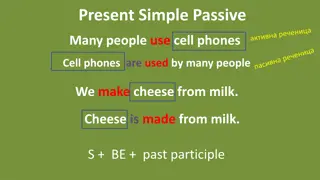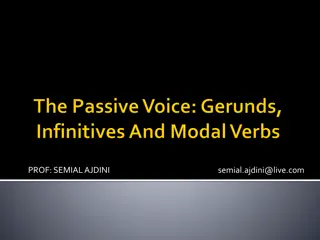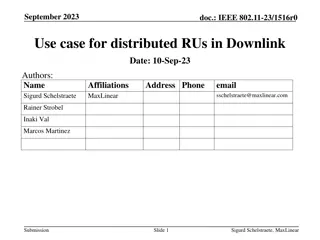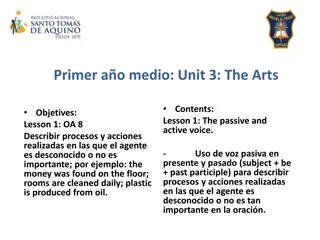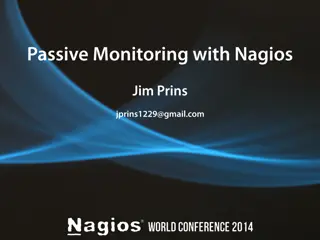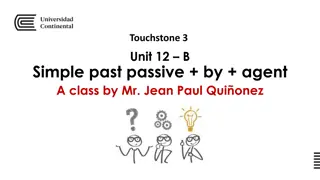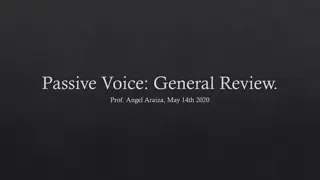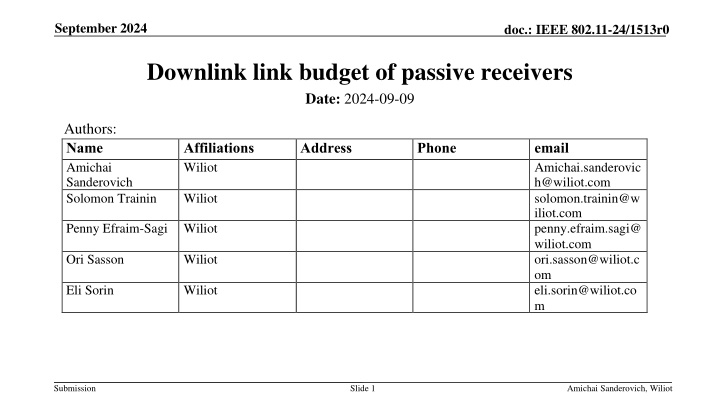
Passive Reception of Downlink for AMP-Only Devices
Explore the link budget analysis for passive reception of downlink in AMP-only devices, focusing on RF energizing and energy storage. The content discusses sensitivity requirements, energy budgets, and proposes passive reception using OOK-Manchester modulation.
Download Presentation

Please find below an Image/Link to download the presentation.
The content on the website is provided AS IS for your information and personal use only. It may not be sold, licensed, or shared on other websites without obtaining consent from the author. If you encounter any issues during the download, it is possible that the publisher has removed the file from their server.
You are allowed to download the files provided on this website for personal or commercial use, subject to the condition that they are used lawfully. All files are the property of their respective owners.
The content on the website is provided AS IS for your information and personal use only. It may not be sold, licensed, or shared on other websites without obtaining consent from the author.
E N D
Presentation Transcript
September 2024 doc.: IEEE 802.11-24/1513r0 Downlink link budget of passive receivers Date: 2024-09-09 Authors: Name Amichai Sanderovich Solomon Trainin Affiliations Wiliot Address Phone email Amichai.sanderovic h@wiliot.com solomon.trainin@w iliot.com penny.efraim.sagi@ wiliot.com ori.sasson@wiliot.c om eli.sorin@wiliot.co m Wiliot Penny Efraim-Sagi Wiliot Ori Sasson Wiliot Eli Sorin Wiliot Submission Slide 1 Amichai Sanderovich, Wiliot
September 2024 doc.: IEEE 802.11-24/1513r0 Abstract We present an example for link budget of downlink reception of AMP-only devices along with RF energizing and energy storage We present the passive receiver as an example. We do not consider active receivers in this contribution. This is purposed mainly for AMP-only devices with active transmitters and long distance backscatters that have RF harvesting and energy storage capabilities Submission Slide 2 Amichai Sanderovich, Wiliot
September 2024 doc.: IEEE 802.11-24/1513r0 Downlink Sensitivity Requirements of AMP-Only Devices We assume integrated energizer for this sensitivity analysis Other cases can be considered as well We use Friis channel: Other flat fading channels can be considered as well Outage probability requirements need to be agreed for fast/slow fading channels We suggest that at least one tag reception mode to have communication receive sensitivity of -54dBm Lower RF harvesting sensitivity of -45dBm is achievable, taking longer charge times but we suggest to focus on higher sensitivity Slide 3 Communication Link RF Harvesting Reader EIRP[dBm] Frequency [GHz] distance [m] 20 2.4 30 0.9 RSSI [dBm] Pin [dBm] @ tag 1 4 -20 -32 -40 -54 -2 -14 -22 -36 10 50 Submission Amichai Sanderovich, Wiliot
September 2024 doc.: IEEE 802.11-24/1513r0 Downlink Reception Energy Budget Downlink should not use much more energy than uplink - avoid longer charging times Considering interference and protocol limitations, we assume that AMP device will need to receive more messages than to transmit Thus we suggest budgeting no more than 1/5 of uplink energy per downlink reception From examples for uplink energy budget ([1]) we budget the downlink reception energy to 0.4-0.8nJ Uplink bitrate [Mbps] Energy uplink [nJ] Energy downlink budget [nJ] 1 2 4 8 16 31.62 6.4 15.81 3.2 7.91 1.6 3.95 0.8 1.98 0.4 Submission Slide 4 Amichai Sanderovich, Wiliot
September 2024 doc.: IEEE 802.11-24/1513r0 Passive Reception of OOK-Manchester Many receiver architectures have been suggested for low energy reception. See [2] for a recent survey, as well as [3-4] for some examples. We propose the use of passive reception for downlink in AMP-only devices. Our analysis showed these receivers can reach the lowest energy consumption per bit, while still providing ballpark sensitivity. We use OOK-Manchester since it is robust and symmetric. Submission Slide 5 Amichai Sanderovich, Wiliot
September 2024 doc.: IEEE 802.11-24/1513r0 Passive Reception Properties Very few active components, no low noise amplifiers (LNAs), no mixers, no LO Amplifications comes from voltage amplification. Noise figure (NF) depends on input signal power (e.g. [5]) Passive mixing done by a rectifier. Baseband is done by a passive FIR or an Integrator. Modest filtering in RF Submission Slide 6 Amichai Sanderovich, Wiliot
September 2024 doc.: IEEE 802.11-24/1513r0 Example for Passive Reception Link Budget KT SNR -174dBm/Hz 12dB Noise figure changes as function of input power DataRate [Mbps] BW [MHz] sensitivity [dBm] NF [dB] 0.0625 0.125 -58.69 52.34 0.25 0.5 -54.67 50.34 0.5 1 2 1 -52.67 49.33 -50.66 48.33 3dB loss due to Manchester encoding is also included No phase noise or clock instabilities were assumed for the link budget Estimated energy budget for reception of 32 bits: 0.4nJ Submission Slide 7 Amichai Sanderovich, Wiliot
September 2024 doc.: IEEE 802.11-24/1513r0 Sync Field Processing 802.11ba used different coding for the sync and the data fields For data it used Manchester encoding while for the sync, no such encoding was used. Since AMP-only receiver is expected to be very simple, it is suggested to keep the same modulation for the sync field and to avoid the need to implement new receiver circuitry for sync processing. Thus we suggest to use Manchester coding also for the sync field. 802.11ba HDR-sync Non Manchester 802.11ba HDR-data Submission Slide 8 Amichai Sanderovich, Wiliot
September 2024 doc.: IEEE 802.11-24/1513r0 References [1] 11-24-1497-00-00bp Uplink Rates for Active Transmission [2] David D. Wentzloff, Low Power Radio Survey, [Online]. www.eecs.umich.edu/wics/low_power_radio_survey.html [3] Moody et al. Interference Robust Detector-First Near-Zero Power Wake- Up Receiver, IEEE JSSC, VOL. 54, NO. 8, AUGUST 2019 [4] Yang et al. A ULP Long-Range Active-RF Tag with Automatic Antenna- Interface Calibration Achieving 20.5% TX Efficiency at -22dBm EIRP, and -60.4dBm Sensitivity at 17.8nW RX Power, ISSCC 2023 [5] Ou et al, A CMOS Envelope Detector for Low Power Wireless Receiver Applications. 2018 16th IEEE International New Circuits and Systems Conference (NEWCAS), Jun 2018, Montr al, Canada. 10.1109/newcas.2018.8585458 . hal-01789807 Submission Slide 9 Amichai Sanderovich, Wiliot
September 2024 doc.: IEEE 802.11-24/1513r0 Strawpoll #1 Do you agree that 11bp defines a new sync field for downlink PHY with the same modulation and coding as the data field? Answer: Y N Abstain Submission Slide 10 Amichai Sanderovich, Wiliot




